Earlier this year, LinkedIn introduced a new format to their paid advertising platform called ‘thought leader ads’. This new advertising option offers an unprecedented opportunity to boost the reach of employee-generated content in front of a carefully selected audience.
In the official announcement that went out, LinkedIn mentioned the following reasons why marketers should consider using the thought leader ads:
- They build credibility by communicating through a trusted voice
- They distinguish your brand as an industry authority
- They help you grow community around your thought leaders
And, here at Tribal Impact, we couldn’t agree more.
We’ve long been advocating for humanising B2B brands by activating employees on social media. We know that this leads to increased brand trust and awareness, shorter deal cycles, larger sales, improved employee engagement and reduced talent attraction costs (just to name a few!).
Data backs this up, too.
- According to PostBeyond, content shared by employees receives 8x more engagement than content shared by brand channels.
- Engaged employees influence 8% more Company Page views, 4x more Company Page followers, 7x more job views, and 4x more job applications (Source: Internal LinkedIn data.)
- Salespeople who regularly share content on their social networks are 45% more likely to exceed their quota (Source: Hinge Research Institute).
So, when we learned about this new ad format, we immediately jumped on the opportunity to test it!
Our Thought Leader Ads Experiment
Here’s what we did when we tested this new ad type over the summer.
To understand the impact, we ran two campaigns simultaneously. Campaign A focused on sponsoring content previously published via Tribal Impact’s LinkedIn company page, whereas Campaign B used the new thought leader ads format, where we amplified content originally published by our CEO, Sarah Goodall.
Campaign A
Below, you’ll see one of 6 ads that we ran as part of this campaign.
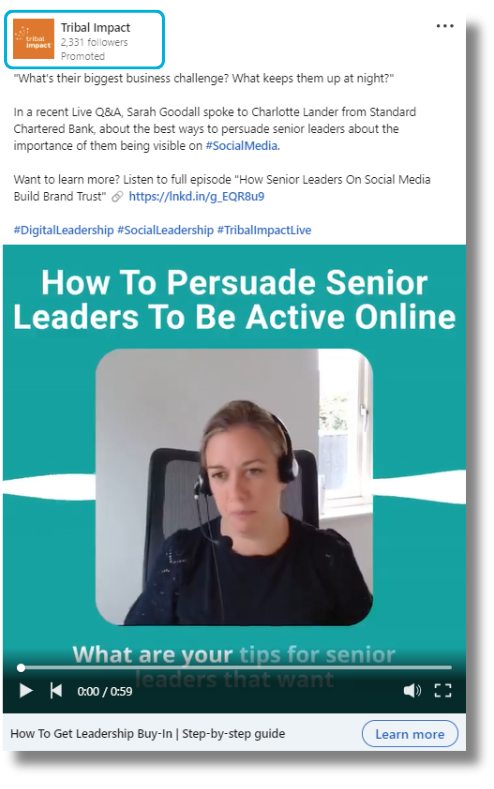
As you can see, the ad looks quite slick. It includes a video with a title and subtitles, together with a coloured background. We purposely chose a colour that isn’t part of our official branding and didn’t use our logo, as we knew that branded content doesn’t always perform well in paid ads.
The post also has accompanying text written in Tribal’s tone of voice by one of our social media specialists. It has a clear, non-salesy call to action that leads the audience to download a guide. You can see this post here.
However, none of this seemed to impress our audience.
The results weren’t great. Overall, the ad received 0.86% CTR and 1.72% engagement rate.
Campaign B
At the same time, we ran another campaign with thought leader ads. Here’s one of the ads:
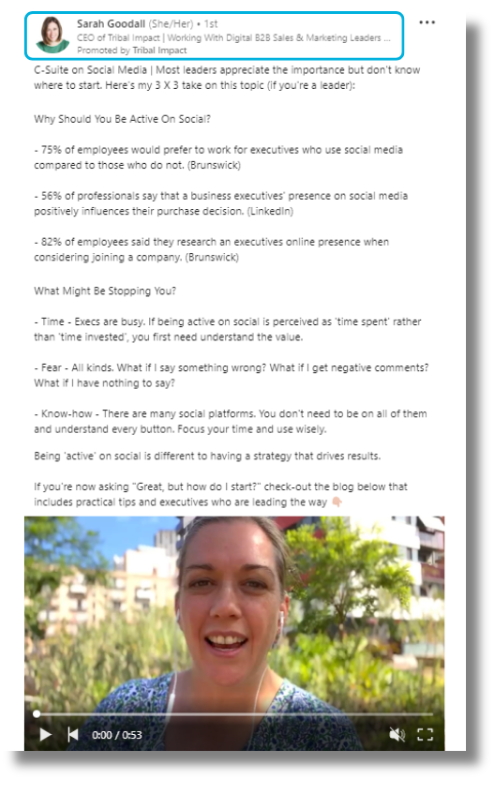
It was initially written and published by Sarah Goodall, our CEO, via her official LinkedIn profile. It includes a video that she created. The video has no branding, title, or subtitles involved (although for accessibility, LinkedIn closed captions are available). It’s just a video of Sarah talking directly to her audience and sharing tips on how to activate leaders on social media. You can see this post here.
Accompanying the video is a text post that Sarah wrote, sharing more tips on the subject and directing people to a blog (via a link in the comments).
The big thing that stands out? Social proof!
The post was liked and engaged with by 60 people before we boosted it via the paid campaign. This gave the new audience a strong indication that the content could be valuable to them, too.
It was a different story in terms of the data.
The post received a whopping 240% higher CTR than the company sponsored post from Campaign A. And a 25% higher engagement rate.
Here’s the data from these two ads compared in a table format: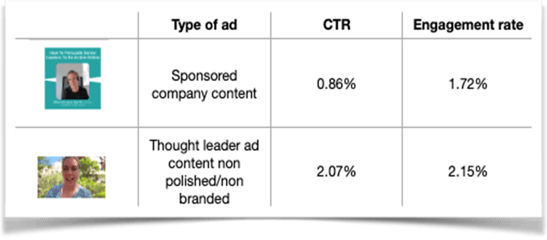
A little note: a CTR of 2.07% may not sound impressive, but if you consider that the target audience were C-Suite level executives from B2B enterprise companies (who are in general less likely to engage unless the content deeply resonates with them), hopefully this puts the result into perspective.
Not All Thought Leader Ads Are Equal
Interestingly, as part of the Campaign B we also ran another post written and originally published by Sarah. This was an audio file with accompanying text. That one didn’t do very well. See if you can identify why:
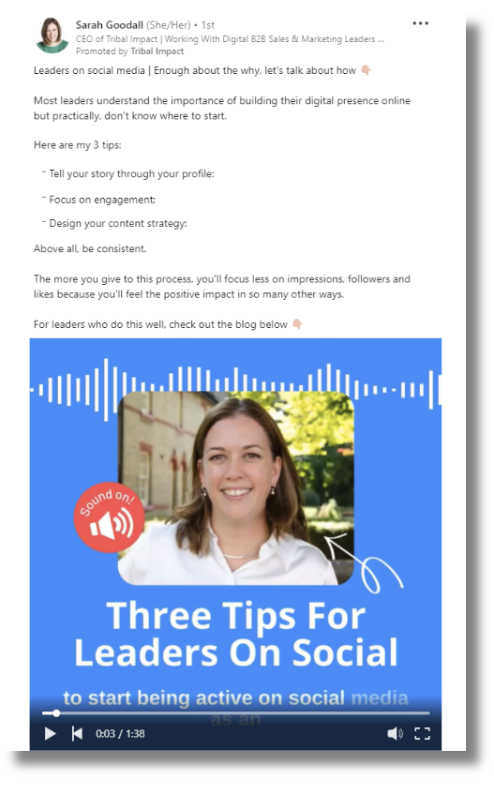
Yes, you’re right- it was too polished.
The title, the subtitles, the background colour. The slick look didn’t seem to resonate with our audience, who want authentic content from individuals, not brands.
This post received 0.64% CTR and 0.74% engagement rate. That’s a shocking 3.2x lower CTR than the less polished first ad. And almost 3x lower engagement rate!
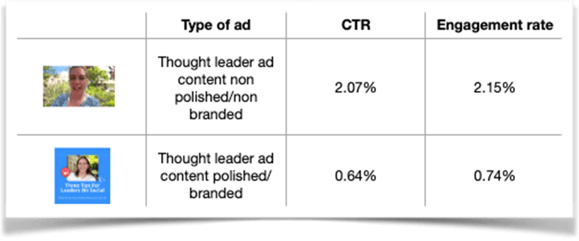
Here's What We Learnt:
- The set up of the campaign is tricky and not easy to find! If you select the wrong objective, ad type, and/or add advertising network, you won’t even be even able to find this format in your Campaign Manager. To save your time, I created this little video explaining how to set it up.
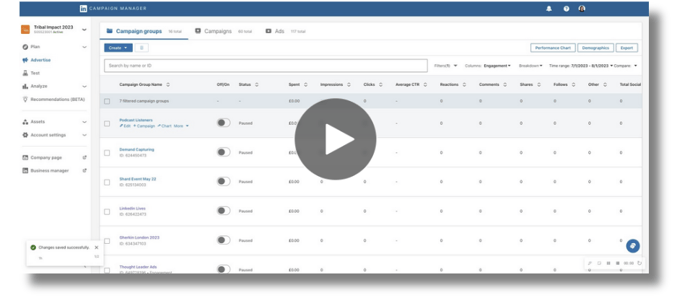
- Do not create posts with emojis. Your ad will look like it's okay to run, but after sending it for approval (which LinkedIn does manually!) it will most likely get rejected. I said ‘most likely’ because all our ads with emojis were rejected but another company we worked with used emojis and had their ads accepted. Could this be because the moderator’s personal preference played a role?
- Do not use capitalised sentences in a post LIKE THIS ONE. That’s instant rejection.
- Add links in the comments of the post, rather than within the post. This gets you more reach for the original, organic posts and could mean more engagement.
- When creating image posts, upload a single image. Thought leader ads do not accept post with multiple images.
- Engagement and CTR are important metrics, but look at other, more important ones too. E.g. check the growth in the followers' rates and direct messages to the person whose posts you use. This is where the real impact of this campaign will be most visible.
Bonus tip: use Sales Navigator to track your paid ads performance
Oh boy…if you haven’t heard of this one already, you’re in for a treat!
Buyer intent reporting within LinkedIn's Sales Navigator tool is a game-changer for further assessment of the impact of your paid social campaigns. It allows you to track how intent changed during the time campaign’s run.
To generate this report, we grabbed all 33 companies that we were targeting via Campaign Manager and uploaded them as an account list directly to Sales Navigator. We did that just before starting the campaign, then monitored the buyer intent changes throughout the time the campaign ran.
Our result? The buyer intent of 30% of the targeted companies increased during this period, providing our sales team with crucial information on which companies might be closer to having a conversation with us.
Since this was the first time we’d done this kind of tracking, this number will now become a benchmark metric for us to improve on moving forward.
Finally, one of the greatest discoveries during this process was that Sales Navigator’s buyer intent report gave us more information regarding specific engagement with your ads than the Campaign Manager.
Just take a look at this.
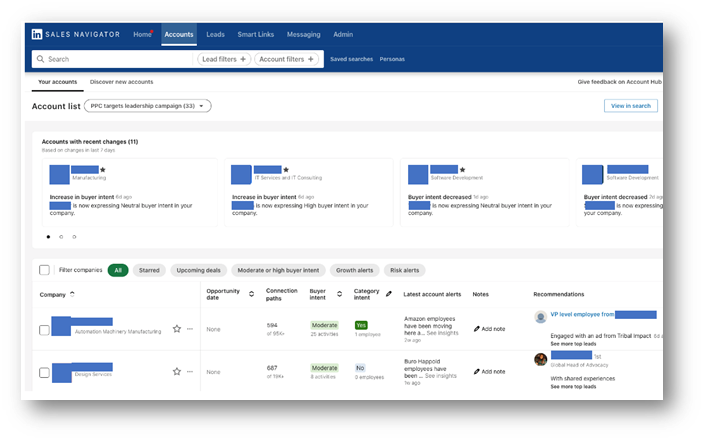
This dashboard allows us to see current buyer intent per company. If you take note of this at the beginning of running the campaign, you can track the changes in intent giving valuable information to your sales team to understand when would be a good time for them to engage with a specific company.
But there is more that this tool can do. Campaign Manager tells us how many clicks we get from a specific campaign that’s running, but we can’t see a breakdown of this per job function from a specific company.
Not a problem for Sales Navigator. We get all that info even with small audiences! Analysis of this kind of data helped us understand specific job functions from specific companies that were interacting with our ads. You don’t see the actual name, but a simple LinkedIn search could help you narrow this list significantly.
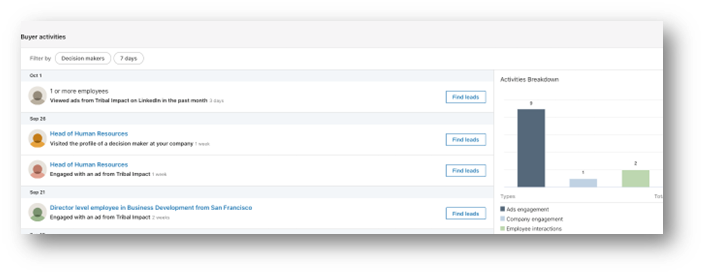
Summary
LinkedIn’s new thought leader ads offer an unprecedented opportunity to promote content from your most trusted and knowledgeable subject matter experts – your employees.To get the most out of this option, keep it casual. A formal, overly polished corporate style won’t resonate with your audience as highly.
Using the ads to boost employees’ posts that performed well gives you social proof that makes people more likely to want to engage with that content, too.
Engagement isn’t the only metric to look at, though. Consider if the post has resulted in an increase in followers or DMs for that thought leader. These will help you determine how well the content resonates with your audience.
And don’t forget to check Sales Navigator for more in-depth information on how your campaign impacted the buyer intent from specific companies and the types of people who engaged with your ad.
If you’d like help developing your thought leadership program, get in touch today to find out how we can help.

